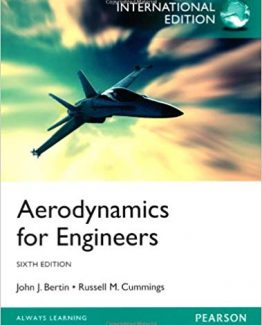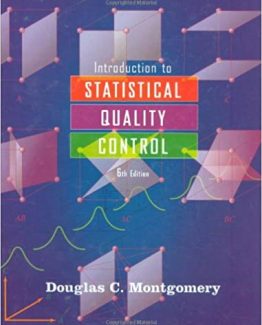An Introduction to 5G: The New Radio, 5G Network and Beyond by Christopher Cox, ISBN-13: 978-1119602668
[PDF eBook eTextbook]
- Publisher: Wiley; 1st edition (December 14, 2020)
- Language: English
- 448 pages
- ISBN-10: 1119602661
- ISBN-13: 978-1119602668
A comprehensive and approachable introduction to 5G.
Written by a noted expert on the subject, An Introduction to 5G: The New Radio, 5G Network and Beyond offers an introductory system-level guide to 5G. The material covered includes:
- The use cases and requirements of the 5G system
- The architecture of the next generation radio access network and the 5G core
- The principles of radio transmission, millimetre waves and MIMO antennas
- The architecture and detailed design of the 5G new radio
- The implementation of HTTP/2 on the service-based interfaces of the 5G core
- The signalling procedures that govern the end-to-end-operation of the system
- The new features that are introduced in Releases 16 and 17
An Introduction to 5G is written for engineering professionals in mobile telecommunications, for those in non-technical roles such as management, marketing and intellectual property, and for students. It requires no more than a basic understanding of mobile communications, and includes detailed references to the underlying 3GPP specifications for 5G. The book’s approach provides a comprehensive, end-to-end overview of the 5G standard, which enables readers to move on with confidence to the more specialized texts and to the specifications themselves.
Table of Contents:
Preface xv
Acknowledgements xvii
List of Abbreviations xix
Chapter 1 Introduction 1
1.1 Architecture of a Mobile Telecommunication System 1
1.1.1 High Level Architecture 1
1.1.2 Internal Architecture of the Mobile 1
1.1.3 Architecture of the Radio Access Network 2
1.1.4 Coverage and Capacity 2
1.1.5 Architecture of the Core Network 3
1.1.6 Communication Protocols 4
1.2 History of Mobile Telecommunications 4
1.2.1 Introduction 4
1.2.2 GSM 5
1.2.3 UMTS 5
1.2.4 LTE 6
1.2.5 LTE-Advanced 6
1.2.6 LTE-Advanced Pro 7
1.2.7 Other Mobile Communication Systems 8
1.3 The Mobile Telecommunication Market 8
1.3.1 Traffic Levels 8
1.3.2 Numbers of Subscriptions 8
1.3.3 Operator Revenue 9
1.4 Use Cases and Markets for 5G 9
1.4.1 5G Research Projects 9
1.4.2 Enhanced Mobile Broadband 9
1.4.3 Massive Machine Type Communication 10
1.4.4 Ultra Reliable Low Latency Communication 11
1.4.5 Vehicle to Everything Communication 12
1.4.6 Network Operation 12
1.5 Technical Performance Requirements 12
1.6 Technologies for 5G 13
1.6.1 Network Function Virtualization 13
1.6.2 Software Defined Networking 14
1.6.3 Network Slicing 15
1.6.4 Technologies for the Air Interface 16
1.7 The 3GPP Specifications for 5G 16
1.8 Architecture of 5G 17
1.8.1 High Level Architecture 17
1.8.2 Architectural Options 18
References 18
Chapter 2 Architecture of the Core Network 23
2.1 The Evolved Packet Core 23
2.1.1 Release 8 Architecture 23
2.1.2 Control and User Plane Separation 24
2.2 The 5G Core Network 24
2.2.1 Representation using Reference Points 24
2.2.2 Representation using Service Based Interfaces 25
2.2.3 Data Transport 26
2.2.4 Roaming Architectures 27
2.2.5 Data Storage Architectures 27
2.2.6 Non-3GPP Access to the 5G Core 28
2.3 Network Areas, Slices and Identities 28
2.3.1 Network Identities 28
2.3.2 Network Slices 29
2.3.3 AMF Areas and Identities 29
2.3.4 UE Identities 30
2.3.5 UE Registration Areas 30
2.4 State Diagrams 31
2.4.1 Registration Management 31
2.4.2 Connection Management 31
2.4.3 Non-3GPP Access 32
2.5 Signalling Protocols 32
2.5.1 Signalling Protocol Architecture 32
2.5.2 Example Signalling Procedures 33
2.6 The Hypertext Transfer Protocol 33
2.6.1 HTTP/1.1 and HTTP/2 33
2.6.2 Representational State Transfer 34
2.6.3 The HTTP/2 Data Layer 35
2.6.4 JSON 35
2.7 Example Network Function Services 36
2.7.1 Network Function Service Registration 36
2.7.2 Network Function Service Discovery 37
2.7.3 Network Function Service Subscription and Notification 38
References 38
Chapter 3 Architecture of the Radio Access Network 43
3.1 The Evolved UMTS Terrestrial Radio Access Network 43
3.1.1 Release 8 architecture 43
3.1.2 Carrier aggregation 43
3.1.3 Dual connectivity 44
3.2 The Next Generation Node B 45
3.2.1 High level architecture 45
3.2.2 Internal architecture 45
3.2.3 Deployment options 46
3.3 Architectural Options 47
3.3.1 Multi Radio Dual Connectivity 47
3.3.2 Options 1 and 3 – EPC, E-UTRAN and MeNB 47
3.3.3 Options 5 and 7 – 5GC, NG-RAN and MeNB 47
3.3.4 Options 2 and 4 – 5GC, NG-RAN and MgNB 48
3.3.5 Data transport 48
3.4 Network areas and identities 49
3.4.1 Tracking areas 49
3.4.2 RAN areas 49
3.4.3 Cell identities 50
3.5 RRC State Diagram 50
3.5.1 5G State Diagram 50
3.5.2 Interworking with 4G 51
3.6 Signalling protocols 51
3.6.1 Signalling protocol architecture 51
3.6.2 Signalling radio bearers 52
References 53
Chapter 4 Spectrum, Antennas and Propagation 57
4.1 Radio Spectrum 57
4.1.1 Radio Waves 57
4.1.2 Use of Radio Spectrum 57
4.1.3 Spectrum Allocations for 5G 58
4.2 Antennas and Propagation 59
4.2.1 Antenna Gain 59
4.2.2 Radio Propagation in Free Space 59
4.2.3 Antenna Arrays for 5G 61
4.3 Radio Propagation Issues for Millimetre Waves 61
4.3.1 Diffraction and Reflection 61
4.3.2 Penetration Losses 62
4.3.3 Foliage Losses 63
4.3.4 Atmospheric Losses 63
4.4 Multipath, Fading and Coherence 64
4.4.1 Introduction 64
4.4.2 Angular Spread and Coherence Distance 64
4.4.3 Doppler Spread and Coherence Time 65
4.4.4 Delay Spread and Coherence Bandwidth 66
4.4.5 Channel Reciprocity 67
References 67
Chapter 5 Digital Signal Processing 71
5.1 Modulation and Demodulation 71
5.1.1 Carrier Signal 71
5.1.2 Modulation 72
5.1.3 The Modulation Process 73
5.1.4 The Demodulation Process 73
5.1.5 Channel Estimation 74
5.1.6 Adaptive Modulation 75
5.2 Radio Transmission in a Mobile Cellular Network 75
5.2.1 Multiplexing and Multiple Access 75
5.2.2 FDD and TDD Modes 75
5.3 Orthogonal Frequency Division Multiple Access 76
5.3.1 Sub-carriers 76
5.3.2 The OFDM Transmitter 77
5.3.3 The OFDM Receiver 77
5.3.4 The Fast Fourier Transform 78
5.3.5 Block Diagram of the OFDMA Downlink 78
5.3.6 Block Diagram of the OFDMA Uplink 79
5.4 Other Features of OFDMA 80
5.4.1 Frequency Specific Scheduling 80
5.4.2 Sub-Carrier Orthogonality 80
5.4.3 Inter-Symbol Interference and the Cyclic Prefix 81
5.5 Signal Processing Issues for 5G 82
5.5.1 Power Consumption 82
5.5.2 Timing Jitter and Phase Noise 83
5.5.3 Choice of Symbol Duration and Sub-Carrier Spacing 84
5.6 Error Management 84
5.6.1 Forward Error Correction 84
5.6.2 Automatic Repeat Request 85
5.6.3 Hybrid ARQ 85
5.6.4 Hybrid ARQ Processes 86
5.6.5 Higher Layer Retransmissions 86
References 87
Chapter 6 Multiple Antenna Techniques 89
6.1 Analogue Beam Selection 89
6.1.1 Spatial Filtering 89
6.1.2 Beam Steering 90
6.1.3 Beamwidth of the Antenna Array 91
6.1.4 Grating Lobes 91
6.1.5 Analogue Signal Processing Issues 92
6.1.6 Beam Management 92
6.2 Digital Beamforming 93
6.2.1 Precoding and Postcoding 93
6.2.2 Digital Signal Processing Issues 93
6.2.3 Diversity Processing 94
6.3 Spatial Multiplexing 94
6.3.1 Principles of Spatial Multiplexing 94
6.3.2 Matrix Representation 95
6.3.3 MIMO and Coherence 96
6.3.4 Uplink Multiple User MIMO 97
6.3.5 Downlink Multiple User MIMO 98
6.3.6 Management of Multiple User MIMO 99
6.3.7 Single User MIMO 99
6.3.8 Signal Processing for Single User MIMO 100
6.3.9 Management of Single User MIMO 102
6.4 Massive MIMO 102
6.4.1 Architecture 102
6.4.2 Received Signal Power 103
6.4.3 Energy Efficiency 104
6.4.4 Spectral Efficiency 104
6.5 Hybrid Beamforming 105
6.5.1 Partly Connected Architecture 105
6.5.2 Fully Connected Architecture 106
6.5.3 Millimetre Wave MIMO 107
6.6 Multiple Antennas at the Mobile 107
6.6.1 Architecture 107
6.6.2 Beam Management 108
References 108
Chapter 7 Architecture of the 5G New Radio 111
7.1 Air Interface Protocol Stack 111
7.1.1 5G Protocol Stack 111
7.1.2 Dual Connectivity 112
7.1.3 Channels and Signals 113
7.1.4 Information Flows 113
7.2 Frequency Bands and Combinations 115
7.2.1 Frequency Bands 115
7.2.2 Band Combinations 115
7.2.3 Bandwidth Classes 116
7.3 Frequency Domain Structure 116
7.3.1 OFDM Numerologies 116
7.3.2 Transmission Bandwidth Configuration 117
7.3.3 Global and Channel Frequency Rasters 118
7.3.4 Common Resource Blocks 118
7.3.5 Bandwidth Parts 119
7.3.6 Virtual and Physical Resource Blocks 119
7.4 Time Domain Structure 120
7.4.1 Frame Structure 120
7.4.2 Timing Advance 121
7.4.3 TDD Configurations 121
7.4.4 Slot Format Combinations 122
7.4.5 Resource Grid 123
7.5 Multiple Antennas 123
7.5.1 Antenna Ports 123
7.5.2 Relationships between Antenna Ports 124
7.6 Data Transmission 124
7.6.1 Transport Channel Processing 124
7.6.2 Physical Channel Processing 125
7.6.3 Analogue Processing 126
References 126
Chapter 8 Cell Acquisition 131
8.1 Acquisition Procedure 131
8.1.1 Introduction 131
8.1.2 Non-Standalone Operation 131
8.1.3 Standalone Operation 132
8.2 Resource Mapping 132
8.2.1 SS/PBCH Blocks 132
8.2.2 Transmission Frequency 133
8.2.3 Transmission Timing 133
8.3 Acquisition of the SS/PBCH Block 134
8.3.1 Primary Synchronization Signal 134
8.3.2 Secondary Synchronization Signal 134
8.3.3 Demodulation Reference Signal for the PBCH 135
8.3.4 Physical Broadcast Channel 135
8.4 System Information 135
8.4.1 Master Information Block 135
8.4.2 System Information Block 1 136
8.4.3 Other System Information Blocks 136
8.4.4 Transmission and Reception of the System Information 136
References 137
Chapter 9 Random Access 139
9.1 Physical Random Access Channel 139
9.1.1 PRACH Formats 139
9.1.2 Generation of the PRACH Preamble 140
9.1.3 Resource Mapping 141
9.2 Random Access Procedure 141
9.2.1 Random Access Preamble 141
9.2.2 Random Access Response 142
9.2.3 Message 3 143
9.2.4 Contention Resolution 143
9.2.5 Contention Free Procedure 143
References 144
Chapter 10 Link Adaptation 145
10.1 CSI Reference Signals 145
10.1.1 Transmission and Reception 145
10.1.2 Resource Mapping 145
10.1.3 CSI-RS Resources 146
10.1.4 CSI-RS Resource Sets 147
10.2 Channel State Information 147
10.2.1 Introduction 147
10.2.2 CSI-RS and SS/PBCH Block Resource Indicators 147
10.2.3 Layer 1 RSRP 148
10.2.4 Rank Indication 148
10.2.5 Precoding Matrix Indicator 148
10.2.6 Channel Quality Indicator 149
10.2.7 Layer Indicator 149
10.2.8 CSI Reporting 150
10.3 Physical Uplink Control Channel 150
10.3.1 Introduction 150
10.3.2 PUCCH Formats 150
10.3.3 PUCCH Resources 151
10.4 Sounding 152
10.4.1 Transmission and Reception 152
10.4.2 Resource Mapping 152
10.4.3 SRS Resources 153
References 15
Chapter 11 Data Transmission and Reception 155
11.1 Introduction 155
11.1.1 Data transmission procedure 155
11.1.2 Downlink control information 155
11.1.3 Radio Network Temporary Identifiers 156
11.2 Transmission and Reception of the PDCCH 156
11.2.1 Transmission of the PDCCH 156
11.2.2 Control Resource Sets 157
11.2.3 Search spaces 158
11.2.4 Reception of the PDCCH 158
11.3 Scheduling Messages 158
11.3.1 DCI Formats 0_0 and 1_0 158
11.3.2 Time Domain Resource Assignment 159
11.3.3 Frequency Domain Resource Assignment 160
11.3.4 Modulation and Coding Scheme 160
11.3.5 Other Fields 161
11.3.6 DCI Formats 0_1 and 1_1 161
11.4 Transmission and Reception of the PUSCH and PDSCH 161
11.4.1 Transport Channel Processing 161
11.4.2 Physical Channel Processing 162
11.4.3 Downlink MIMO 162
11.4.4 Uplink Codebook Based MIMO 163
11.4.5 Uplink Non-Codebook Based MIMO 163
11.5 Reference Signals 164
11.5.1 Demodulation Reference Signals 164
11.5.2 Phase Tracking Reference Signals 165
11.6 Hybrid ARQ Acknowledgements 165
11.6.1 Downlink Acknowledgements of Uplink Data 165
11.6.2 Uplink Acknowledgements of Downlink Data 165
11.6.3 Timing of Uplink Acknowledgements 166
11.7 Other DCI Formats 167
11.7.1 Introduction 167
11.7.2 Slot Format Indications 167
11.7.3 Pre-Emption Indications 167
11.7.4 Transmit Power Control Commands 168
11.8 Related Procedures 168
11.8.1 Scheduling Requests 168
11.8.2 Semi-Persistent and Configured Scheduling 168
11.8.3 Discontinuous Reception 169
11.9 Performance of 5G 170
11.9.1 Peak Data Rate 170
11.9.2 Typical Cell Capacity 172
References 172
Chapter 12 Air Interface Layer 2 177
12.1 Medium Access Control 177
12.1.1 Protocol Architecture 177
12.1.2 Scheduling 177
12.1.3 Logical Channel Prioritization 178
12.1.4 Multiplexing and Demultiplexing 178
12.1.5 MAC Control Elements 179
12.2 Radio Link Control 180
12.2.1 Protocol Architecture 180
12.2.2 Transparent Mode 180
12.2.3 Unacknowledged Mode 180
12.2.4 Acknowledged Mode 181
12.3 Packet Data Convergence Protocol 182
12.3.1 Protocol Architecture 182
12.3.2 Transmission and Reception 182
12.3.3 PDCP Duplication 183
12.3.4 Prevention of Packet Loss during a Change of Node 183
12.3.5 Header Compression 184
12.4 Service Data Adaptation Protocol 184
References 184
Chapter 13 Registration Procedures 187
13.1 Power-On Sequence 187
13.2 Network and Cell Selection 188
13.2.1 Network Selection 188
13.2.2 Cell Selection 189
13.3 RRC Connection Establishment 190
13.3.1 RRC Connection Establishment with a gNB 190
13.3.2 Initial UE Message 191
13.3.3 RRC Connection Establishment with an eNB 191
13.4 Registration Procedure 191
13.4.1 Registration without AMF Change 191
13.4.2 Registration with a New AMF 193
13.4.3 Registration with AMF Re-allocation 194
13.5 Deregistration Procedure 195
References 195
Chapter 14 Security 199
14.1 Security Principles 199
14.2 Network Access Security 200
14.2.1 Network Access Security Architecture 200
14.2.2 Key Hierarchy 201
14.3 Network Access Security Procedures 201
14.3.1 Subscription Concealed Identifier 201
14.3.2 Authentication and Key Agreement 202
14.3.3 Activation of Non-Access Stratum Security 203
14.3.4 Activation of Access Stratum Security 204
14.3.5 Key Handling during Mobility 204
14.3.6 Key Handling during State Transitions 204
14.3.7 Ciphering 205
14.3.8 Integrity Protection 205
14.4 Network Domain Security 206
14.4.1 Network Domain Security Architecture 206
14.4.2 Network Domain Security Protocols 206
14.5 Service Based Architecture Domain Security 207
14.5.1 Security Architecture 207
14.5.2 Initial handshake procedures over N32-c 208
14.5.3 Forwarding of JOSE protected messages over N32-f 208
References 209
Chapter 15 Session Management, Policy and Charging 211
15.1 Types of PDU Session 211
15.1.1 IP PDU Sessions 211
15.1.2 Ethernet PDU Sessions 212
15.1.3 Unstructured PDU Sessions 212
15.2 Quality of Service 213
15.2.1 Packet Flows, Service Data Flows and QoS Flows 213
15.2.2 Quality of Service Parameters 214
15.2.3 Charging Parameters 216
15.3 Implementation of PDU sessions 216
15.3.1 Bearers and Tunnels 216
15.3.2 User plane protocols 217
15.3.3 End-to-end protocol stack 217
15.3.4 Multiple PDU Session Anchors 218
15.3.5 PDU Session Anchor Relocation 219
15.4 Policy and Charging Control Architecture 219
15.4.1 High Level Architecture 219
15.4.2 Support for 3GPP services 221
15.4.3 Northbound API 221
15.4.4 Charging and Billing System 222
15.5 PDU Session Establishment Procedures 223
15.5.1 PDU Session Establishment 223
15.5.2 Interactions with the Policy and Charging Control System 224
15.5.3 PDU Session Release 225
15.6 Traffic Steering 225
15.6.1 Traffic Steering Request 225
15.6.2 Addition of a PDU Session Anchor 226
15.6.3 Change of PDU Session Anchor 226
References 227
Chapter 16 Mobility Management in RRC_CONNECTED 233
16.1 Introduction to RRC_CONNECTED 233
16.1.1 Principles 233
16.1.2 Dual Connectivity 233
16.1.3 PDU Sessions 234
16.2 Measurement Configuration and Reporting 234
16.2.1 Measurement Configuration and Reporting Procedure 234
16.2.2 Measurement Objects 235
16.2.3 Reporting Configurations 236
16.2.4 Measurement Gaps 237
16.2.5 Measurement Reporting 238
16.3 Handover Procedures 238
16.3.1 Xn-based Handover Procedure 238
16.3.2 Path Switch Procedure 240
16.3.3 NG-based Handover Procedure 240
16.3.4 Handovers between a gNB and an ng-eNB 240
16.4 Dual Connectivity Procedures 241
16.4.1 Secondary Node Addition 241
16.4.2 QoS Flow Mobility Procedure 242
16.4.3 Other Dual Connectivity Procedures 243
16.5 State Transitions out of RRC_CONNECTED 243
16.5.1 Core Network Assistance Information 243
16.5.2 Transition to RRC_IDLE 243
16.5.3 Transition to RRC_INACTIVE 244
References 245
Chapter 17 Mobility Management in RRC_IDLE 247
17.1 Introduction to RRC_IDLE 247
17.1.1 Principles 247
17.1.2 Inactive PDU Sessions 247
17.2 Cell Reselection Procedures 248
17.2.1 Introduction 248
17.2.2 Intra-Frequency Measurement Triggering 248
17.2.3 Intra-Frequency Cell Reselection 249
17.2.4 Inter-Frequency Measurement Triggering 250
17.2.5 Inter-Frequency Cell Reselection 250
17.2.6 Fast Moving Mobiles 251
17.3 Registration Updating 251
17.3.1 Registration Update Procedure 251
17.3.2 Network Reselection 252
17.4 State Transitions out of RRC_IDLE 252
17.4.1 Mobile Triggered Service Request 252
17.4.2 Network Triggered Service Request 253
References 254
Chapter 18 Mobility Management in RRC_INACTIVE 257
18.1 Introduction to RRC_INACTIVE 257
18.1.1 Principles 257
18.1.2 Suspended PDU Sessions 258
18.2 Mobility Management 258
18.2.1 RAN-Based Notification Area Update 258
18.2.2 Registration Update 259
18.2.3 Mobility between a gNB and an ng-eNB 260
18.3 State Transitions 260
18.3.1 Transition to RRC_IDLE 260
18.3.2 Mobile Triggered Resumption of the RRC Connection 261
18.3.3 Network Triggered Resumption of the RRC Connection 261
References 262
Chapter 19 Inter-Operation with the Evolved Packet Core 265
19.1 Inter-Operation Architectures 265
19.1.1 Migration Architecture 265
19.1.2 Interworking Architecture 266
19.1.3 Signalling Protocols 266
19.1.4 State Diagrams 266
19.2 Registration Modes 267
19.2.1 Single Registration Mode 267
19.2.2 Dual Registration Mode 267
19.2.3 Temporary Identities 268
19.3 Use of the Migration Architecture 268
19.3.1 Configuration Procedures 268
19.3.2 Mobility in RRC_IDLE 268
19.3.3 RRC Release with Redirection from RRC_CONNECTED 269
19.4 Interworking without N26 269
19.4.1 Configuation Procedures 269
19.4.2 Mobility in Single Registration Mode 270
19.4.3 Mobility in Dual Registration Mode 270
19.5 Interworking with N26 270
19.5.1 Configuration Procedures 270
19.5.2 Mobility in RRC_IDLE 271
19.5.3 Handovers in RRC_CONNECTED 272
References 273
Chapter 20 Release 16 and Beyond 275
20.1 Vehicle to Everything (V2X) Communications 275
20.1.1 Introduction 275
20.1.2 Architectural Enhancements 276
20.1.3 Device to Device Communications 276
20.2 Location Services 277
20.2.1 Introduction 277
20.2.2 System Architecture 278
20.2.3 Enhancements to the Air Interface 278
20.3 Integrated Access and Backhaul 279
20.3.1 Introduction 279
20.3.2 High Level Architecture 279
20.3.3 Architectural Details 280
20.4 Non Terrestrial Networks 281
20.4.1 Introduction 281
20.4.2 Design Challenges 281
20.5 Massive Machine Type Communications 282
20.5.1 Introduction 282
20.5.2 Enhancements to the 5G Core Network 282
20.5.3 NR Light 283
20.6 Other New Features and Studies 283
20.6.1 Enhancements to the Service Based Architecture 283
20.6.2 Support for Vertical and LAN Services 284
20.6.3 Self-Optimizing Networks 284
20.6.4 Use of Unlicensed Spectrum 285
20.6.5 Reduction of Cross Link Interference 285
20.6.6 Further Enhancements to the 5G New Radio 285
References 286
Bibliography 291
Christopher Cox, PhD, is Director of Chris Cox Communications Ltd, UK. He is a professional technical trainer and consultant in mobile telecommunications, and an expert in 5G, 4G and 3G communication technologies. He draws on this expertise in delivering technical training and intellectual property consultancy for clients drawn from network operators and equipment manufacturers worldwide.
What makes us different?
• Instant Download
• Always Competitive Pricing
• 100% Privacy
• FREE Sample Available
• 24-7 LIVE Customer Support






Reviews
There are no reviews yet.